Keywords: Rose, Pink, Blush, White Zinfandel, RAP, Chardonnay, Sauvignon Blanc, Viognier, Pinot Grigio, Pinot Gris, Reisling, Gewurztraminer, Prosecco, Champagne, Pierre Jouet, Veuve Clicquot, Clairett de Die, Cremant d’Alsace, Domaine Allimant-Laugner, sparkling wine, fruit-flavored sparkling wine, dessert wine, Sauterne, Tokay, ice wine, Port, Madeira, Late Harvest Wine, Claret, learning more about wine.
Now let's talk about wines that aren't red.
As a beginner in wine tasting, don't fall into the trap of focusing only on one kind of wine. If you try a Chardonnay and like it, the temptation is to just drink Chards from now on. After all, there are so MANY kinds of wines, and it's confusing! Right?
Well Yes, it's confusing, but No, that's not an excuse to stop experimenting. You would miss out on some wonderful wines if you're not willing to try new things. This is a rich opportunity to find new fun things to taste.
A lot of them you won't like. But a lot of them you will. I promise!
Many people only drink white wines. An equal number of people only drink reds. Even more people think Rosé's are a bad joke, and too sweet -- and so they think they don't like roses. And also they think they don't like "sweet wines."
Don't be those people.
Open your mind, your palate, and your glass to lots of different kinds of wine. If you haven't already tried THAT wine, from THAT winemaker, in THAT vintage -- you don't know what it tastes like. Give yourself a chance to be surprised. (Or to confirm your suspicion that you won't like it!) Especially if it's being offered to you. (It's harder to justify blind experiment if you're paying to buy a whole bottle of unknown wine.)
We'll review white wines, champagnes, and dessert wines. Let's start with America's most misunderstood wine.....
Rosé
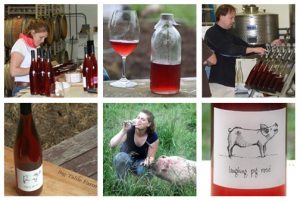 |
| Laughing Pig makes delicious Rose |
Unfortunately, when people get out of college and graduate from white Zinfandel, they learn all the wrong lessons -- they think what they don't like is Rosé, and sweet wine. This is wrong: What you get tired of is poorly made sweet roses. A well-made Rosé can be divine, as you will discover when you get a chance to try it. And roses come in everything from very dry to very sweet.
Rose is coming back in fashion in the USA, happily – so if you find a Rosé or two that you like, you can be leading-edge and hip. (Watch for a local Rosé tasting event if one comes to your area. "RAP" is an annual Rosé-tasting event in San Francisco, but they may have similar events around the country.)
Rose can be made from any red-skinned grape -- Pinot Noir (the standard in France), Cabernet, Merlot, Zinfandel, Barbera -- so there is more variety in Rosé than in any other type of wine--and more different shades and types of pink than you can imagine. Rose is usually mild and easy for beginners. It's an adventure. They can be completely 'dry' (not sweet), or lightly sweet, and everything in between, and can have a lovely aroma. Try them!
(A bonus: Since roses aren't popular in America, yet every winemaker loves roses, they will each make a little Rosé, just for themselves. Since there is no 'standard' for how Rosé should taste -- no 'market' they need to conform to -- each winemaker makes his or her own Rosé to suit his or her own taste -- so every Rosé tastes a bit different from every other maker's Rosé. And that, my friends, is the very definition of wine adventure!)
White Wines
The most popular white wine in America is Chardonnay, which can be an excellent wine but is widely manufactured to be cheap and enjoyable for those with unsophisticated palates. Chards can be too vanilla-y and oaky, so you can get tired of them after a while.BTW, pronunciation: Being French words, there are extra letters not pronounced: "Soh – Vinn – Yohn." And while we're at it, the French leave off the last consonant when pronouncing a lot of wine words: Cabernet drops the T: "Cab-Ber-Nay" and so does Pinot Noir: "Pee-No No-are." Once you've mastered these, be sure to look pityingly at your friends when they mangle the words. It's mean, but it's fun.
Here are some other, even lighter and often fruitier, white wines -- but fair warning: How they taste varies widely from one winemaker to another. But none are harsh; at worst, they can be bland.
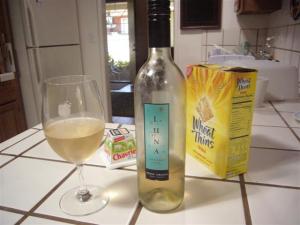 |
| Luna Vineyards Pinot Grigio |
Pinot Gris ("Pee-No Gree"), called Pinot Grigio in Italy (Pee-No Gree-Jee-Oh). Aromas of flowers and fruit like peaches and pears and grapefruit. Often not a very strong taste at all.
US winemakers produce these types of wine as well. Shop around until you find a version you like.
German/Austrian/Alsatian White Wines
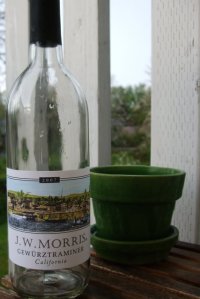 |
| 2007 JW Morris Gewürztraminer - $4 |
German white wines are in a class by themselves. They taste not at all like other whites; they are less acidic, for one thing; many of them tend to be slightly sweet, in a good way. They can be pricey (but see Trader Joe's 'JW Morrison' brand, which can be tasty and TJ-cheap).
Try any Riesling ("rees-ling") you see, or any Gewurztraminer ("Gay-VORTZ-tramminner" with the "tramminner" part run together in a burst; some people just say "GayVORTZ" and leave off the end part). You may be pleasantly surprised. The bottle labels are generally unpronounceable: "Spatauslese," for example. Don't even bother. My favorite German white wine is something called Bott Freres; from Alsace on the French-German border, about $25, and worth it. Another favorite is wines from the importer "Dr. Loosen" (pronounced, approximately, "Doctor Loow-zin"), a little pricier.
White wines from Germany, Austria, and the Alsace can be very dry, or medium-dry, or a little sweet. Everyone buys the dry, but you will be surprised how much you enjoy the off-dry/semi-sweet or medium-sweet ones as well. Tell the wine-store clerk "I'm looking for a Riesling, not too dry" and you'll get something pleasant.
Another fun white is the Italian sparkling wine called Prosecco – it's light, a little bubbly, a little sweet, and very easy and fun to drink; it's also somewhat inexpensive. Consider it as an enjoyable alternative to Champagne. (For one thing, it goes better with wedding cake....Hint hint.)
Champagne
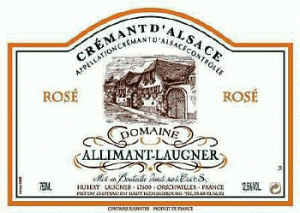 |
| Cremant d'Alsace is a Champagne alternative--Delicious! |
Champagne is a tough one. A lot of 'girls' like Champagne, but I find cheap champagnes to be harsh, with a sharp edge. Good champagnes range from $35 to $95 for a decent one, and hundreds of dollars for spectacular vintages. If you absolutely have to buy a bottle of champagne and make an impression, here are brands and types you can safely pay $30--$50 for and not embarrass or disappoint yourself:
- Chandon – At $12, a drinkable champagne at a surprising price (Shahn-Dohn).
- Perrier Jouet makes very tasty champagnes at a midrange price ($50?) (Perr-y-aay Jooo-aay)
- Veuve Clicquot (pronounced, approximately, "Vuuhv–Klee-Koh – good luck) makes a tasty champagne called Ponsardin.
- A French nonofficial champagne called Clairett de Die - $13, actually, and I think it's as tasty as any bottle many times the price. Someone who knows French bubbly will be impressed that you've even heard of it. It's not "champagne" because it's not made in Champagne province, and it's made with a different process than the "methode champaignois." (Clair-ette deh Dee-aay)
- Another non-Champagne champagne is a type called Cremant d'Alsace, also uses a different process and therefore is not "champagne," but tastes the same, but kind of creamier, not as sharp, and not awfully expensive. (Cream-ahnt duh-Al-say-s). One maker I've tried is Domaine Allimant-Laugner. In the U.S., Schramsberg makes a Cremant, at $32, that I find creamy and delicious.
Dessert Wine
Do not, in my presence, announce that you "don't like" sweet wines. You are being silly. The only way you could "not like" all sweet wines is if you don't like sweets. You like ice cream, don't you? Have a favorite candy bar? Eat Lifesavers? Lollipops? M&Ms? Do you ever eat dessert? I mean, when you're not watching your waistline?Of course you like sweet things. And you'll find you like well-made sweet wines too. Try some until you find which you like and which you don't.
Dessert wines are meant to be sipped, not swilled, and are often served in tiny glasses, for two very good reasons: First, they can be very alcoholic (not all, but many--check the label). Second, many are very VERY sweet, and are meant to be served at the end of the day, or winetasting, or after dinner--just like dessert.
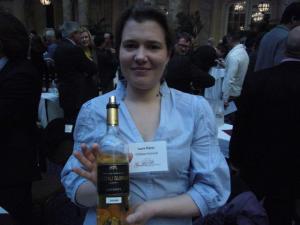 |
| Chateau Guiraud Sauterne, France--Wow! |
There are both red and white dessert wines. The whites tend to cluster around a French white called SAUTERNE (so – tern). There are French Sauternes that are unbelievably expensive -- hundreds of dollars for half-sized bottles. But there are less famous French Sauternes that cost $15-$30 for those half-sized bottle -- and taste just as good, one advantage to having an unsophisticated palate! There is a Hungarian white called Tokay (toe-kay, also spelled Tokaj, but pronounced the same), with expensive famous labels. If you see either of these being served, get in line. At least try it.
Another famously tasty, very sweet white dessert wine is Canadian Ice Wine. Its tall, thin bottles are, sadly, pricey too. It is made from grapes left on the vine to freeze, and picked in February (what the birds haven't eaten). And. it. is. delicious!
 |
| Madeiras from 1922 and 1968 ($$$!) |
In the Reds category, the first big grouping is PORT. As a beginner, simply avoid Ports; they can be very good, but they can overwhelm the beginning drinker because they have a dose of brandy whiskey added at the end of the production process. Ugh. Sherry is also challenging for beginners. Try Madeira instead -- it's very sweet, very intense, almost like liquid raisins, but much easier to handle. Older ones are expensive -- $500 for a 1960, anybody? -- but younger ones can be reasonably priced. An open bottle of any of the above will last for weeks, even months, without changing their taste.
 |
| Rosie Rabbit Late Harvest Zinfandel. Yes! |
A better bet for beginners is a "Late Harvest" wine – these are made from grapes picked as late in November as possible, so they have started to dry out – drops are squeezed out to make this FAB-ulously sweet and tasty wine. American winemakers create late-harvest wines from a wide variety of grapes -- Zins, Cabs, Pinots, Syrahs, Muscats, or white grapes like Semillon and Viognier. Moderately pricey half bottles can be sipped, and left open for weeks. Yum!
Miscellaneous Factoids About Your Wines
Wine labeled as "Claret" is a Bordeaux-style wine; claret is the traditional English term for French Bordeaux.
Wine is made in every state in the USA; many are very nice, many are very interesting. A few are not nice or interesting but still worth trying just for the novelty. In New York State, in the Finger Lakes region they are experimenting with wines made from native American grapes such as "Cayuga," and these are very much worth trying, especially as a beginning wine drinker, because they are light and easy to drink.
Wines are also made in virtually every country in the world, with varying degrees of success. Lucky for us wine tasters, the science of winemaking has made such great strides in recent decades that you will see even more very good wines coming from apparently improbable places in the future. I've had very good wine from Mexico, from Sicily, and from Israel; I've had very bad wine from China, but I hold out great hope for an evolving Chinese winegrowing industry.
Australia, of course, has such good wines -- not just inexpensive, fun-to-drink supermarket wines, but sophisticated German-style whites as well -- that if you visit that land, you really must try to visit a winery or two. Likewise South Africa, which produces unusual wines as well as the usual.
Learning More--the Easiest Way
You can only really learn about wine by tasting it -- often and in variety. Luckily, this is a fun thing to do. Unluckily, it can be costly -- if you do it by yourself. It's also less fun that way.So do it the easier and more-fun way: Taste with friends. Go to wine tastings with friends. Visit wineries with friends. Throw wine-tasting parties--this can be best of all because you can just declare a BYOB party, pick a theme (my group, BAWDY, has done everything from "California Cabs" to "Favorite Everyday Wines," and I'm lucky enough to belong to The Pompous Twits, which has members with real wine cellars (yes!).
Don't got no wine-loving friends? Not to worry: Go over to Zenergo (the host of this blog), sign up (easy and free), join the 'Wine Tasting' Activity, and search for others like yourself in your area. Search for winetasting groups. Search for winetasting events. Or start a group of your own and recruit local wine lovers and wanna-be wine lovers.
Our Next Post: What You're Likely To Like
There are more kinds of wines and winemaking areas than we've covered in these two blog posts so far -- but don't worry about it. Just scanning these two blog posts puts you ahead of quite a few of your friends and drinking companions! Congratulations! You are just a few more blog posts away from being a wine snob! (Just kidding. You are just a few blog posts away from being a wine enthusiast!)In another post, we'll talk about kinds of wines that beginners are most likely to enjoy tasting -- and wines you are likely to dislike (because they have strong, aggressive flavors that take getting used to). Even better, we'll give you some tips on how to buy wine at a store for a party or as an impressive gift without wasting your money; and what to do when you're at a fancy restaurant and somebody asks you to order the wine! (Step one: Don't panic! We have a plan!)
Be sure to comment below--questions accepted, compliments welcomed -- and be sure to share with your friends!

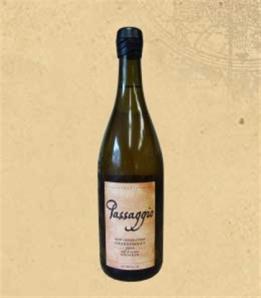



No comments:
Post a Comment